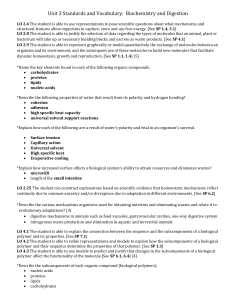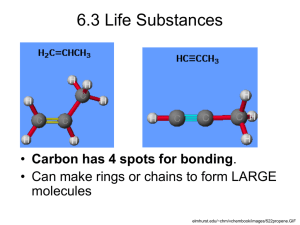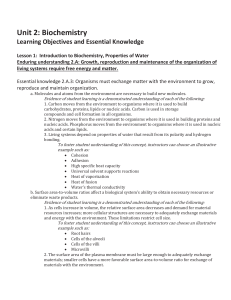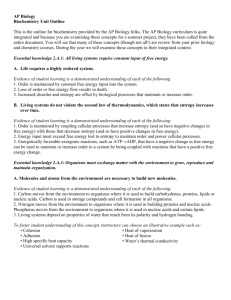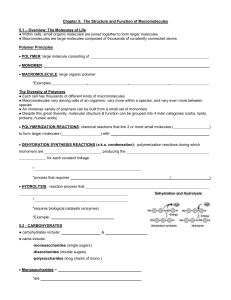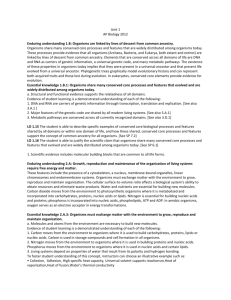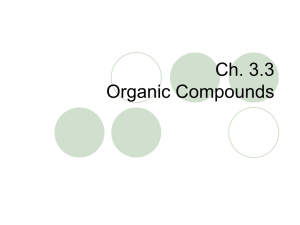Unit 1: Chemistry of Life Learning Targets
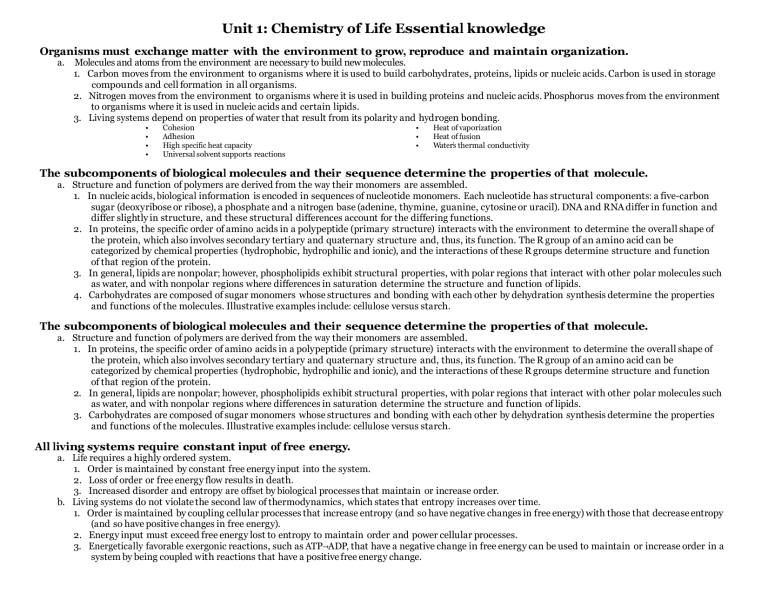
Unit 1: Chemistry of Life Essential knowledge
Organisms must exchange matter with the environment to grow, reproduce and maintain organization.
a. Molecules and atoms from the environment are necessary to build new molecules.
1. Carbon moves from the environment to organisms where it is used to build carbohydrates, proteins, lipids or nucleic acids. Carbon is used in storage compounds and cell formation in all organisms.
2. Nitrogen moves from the environment to organisms where it is used in building proteins and nucleic acids. Phosphorus moves from the environment to organisms where it is used in nucleic acids and certain lipids.
3. Living systems depend on properties of water that result from its polarity and hydrogen bonding.
• Cohesion
• Adhesion
• High specific heat capacity
• Universal solvent supports reactions
• Heat of vaporization
• Heat of fusion
• Water’s thermal conductivity
The subcomponents of biological molecules and their sequence determine the properties of that molecule.
a. Structure and function of polymers are derived from the way their monomers are assembled.
1. In nucleic acids, biological information is encoded in sequences of nucleotide monomers. Each nucleotide has structural components: a five-carbon sugar (deoxyribose or ribose), a phosphate and a nitrogen base (adenine, thymine, guanine, cytosine or uracil). DNA and RNA differ in function and differ slightly in structure, and these structural differences account for the differing functions.
2. In proteins, the specific order of amino acids in a polypeptide (primary structure) interacts with the environment to determine the overall shape of the protein, which also involves secondary tertiary and quaternary structure and, thus, its function. The R group of an amino acid can be categorized by chemical properties (hydrophobic, hydrophilic and ionic), and the interactions of these R groups determine structure and function of that region of the protein.
3. In general, lipids are nonpolar; however, phospholipids exhibit structural properties, with polar regions that interact with other polar molecules such as water, and with nonpolar regions where differences in saturation determine the structure and function of lipids.
4. Carbohydrates are composed of sugar monomers whose structures and bonding with each other by dehydration synthesis determine the properties and functions of the molecules. Illustrative examples include: cellulose versus starch.
The subcomponents of biological molecules and their sequence determine the properties of that molecule.
a. Structure and function of polymers are derived from the way their monomers are assembled.
1. In proteins, the specific order of amino acids in a polypeptide (primary structure) interacts with the environment to determine the overall shape of the protein, which also involves secondary tertiary and quaternary structure and, thus, its function. The R group of an amino acid can be categorized by chemical properties (hydrophobic, hydrophilic and ionic), and the interactions of these R groups determine structure and function of that region of the protein.
2. In general, lipids are nonpolar; however, phospholipids exhibit structural properties, with polar regions that interact with other polar molecules such as water, and with nonpolar regions where differences in saturation determine the structure and function of lipids.
3. Carbohydrates are composed of sugar monomers whose structures and bonding with each other by dehydration synthesis determine the properties and functions of the molecules. Illustrative examples include: cellulose versus starch.
All living systems require constant input of free energy.
a. Life requires a highly ordered system.
1. Order is maintained by constant free energy input into the system.
2. Loss of order or free energy flow results in death.
3. Increased disorder and entropy are offset by biological processes that maintain or increase order. b. Living systems do not violate the second law of thermodynamics, which states that entropy increases over time.
1. Order is maintained by coupling cellular processes that increase entropy (and so have negative changes in free energy) with those that decrease entropy
(and so have positive changes in free energy).
2. Energy input must exceed free energy lost to entropy to maintain order and power cellular processes.
3. Energetically favorable exergonic reactions, such as ATP → ADP, that have a negative change in free energy can be used to maintain or increase order in a system by being coupled with reactions that have a positive free energy change.
Unit 1: Chemistry of Life
Learning Targets
Text
Ref.
Learning Target
I can explain the connection between the sequence and the subcomponents of a biological polymer and its properties.
I can refine representations and models to explain how the subcomponents of a biological polymer and their sequence determine the properties of that polymer.
I can use models to predict and justify that changes in the subcomponents of a biological polymer affect the functionality of the molecule
I can explain how biological systems use free energy based on empirical data that all organisms require constant energy input to maintain organization, to grow and to reproduce.
Evidence
(capture your understanding)
4=Expert 3=I get it 2=I kind of get it 1=I’m lost
Self-
Score
(4-1)
